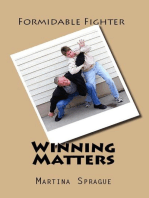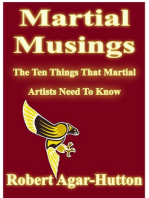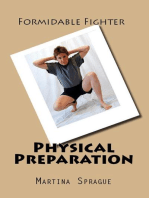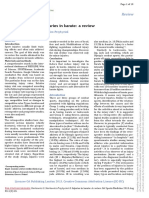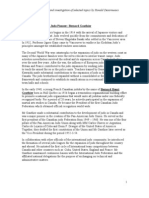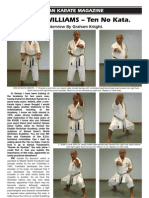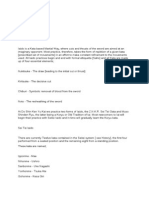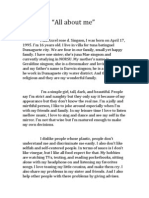Interview With Karl Geis PDF
Interview With Karl Geis PDF
Uploaded by
r_rochetteCopyright:
Available Formats
Interview With Karl Geis PDF
Interview With Karl Geis PDF
Uploaded by
r_rochetteOriginal Title
Copyright
Available Formats
Share this document
Did you find this document useful?
Is this content inappropriate?
Copyright:
Available Formats
Interview With Karl Geis PDF
Interview With Karl Geis PDF
Uploaded by
r_rochetteCopyright:
Available Formats
Interview with Karl Geis by David Russel
Russell: There is some controversy in Aikido circles concerning how to deal with the speed of a karatekas attack. How do you train your students to deal with these attacks? Karl Geis: I believe that a good starting point lies in the definition of what is a martial artist. There are basically 3 ways to defend from an attack and all three are effective if they are individually used as they were originally conceived. We have force meets force arts, such as karate, boxing, taekwondo and other striking arts. Secondly, we have the grappling arts such as Judo, Wrestling, etc. Third we have the avoidance arts such as aikido and some forms of Jujitsu etc. We find that the three arts are mutually exclusive. For example, its hard to grapple and strike at the same time. It is hard to avoid force and grapple at the same time, and it is hard to strike and avoid force at the same time. Citing the above principles, my definition of a martial artist is a person who studies one of these three ideas exclusively. When an art is studied in this way, the subconscious quickly learns how to respond to almost every conceivable attack. However if we mix the arts, strange stuff happens. For example, if the subconscious has been taught to block with left hand and strike with the right when dealing with a right hand punch, the response will be instant. However, if we also have studied avoiding the punch, our subconscious becomes confused and throws the decision back to the conscious mind. The difference is that the subconscious makes a decision in 1/25 of a second, whereas the conscious mind makes a decision in 3/4 of a second, approximately 18 times faster. Any martial artist who has truly internalized his/her art will not make the mistake of being seduced into the other guys game. For example, if we begin trying to deal with a punch the way a striking artist deals with a punch, we are lost. If however, we deal with the punch by inconveniencing our attacker I think the best way to do this is by not being where the martial artists that he is used to training with is usually standing. The attacker may now be forced to deal with a condition that he rarely sees and must adjust his strategy accordingly. Either way the guy that used movement as a part of his defense is not hurt and usually has a lot of time to get ready to move again. It is common knowledge that anybody who attacks a Karateka, Boxer, Taekwondo player or other striking art guy is taking a great risk and can get hammered. However, as we examine the weaknesses as well as the strengths of any striking art we find many holes in their armor. If we execute our art within these holes of weakness we find that we can control the situation with surprising ease. What are the weaknesses of the striking arts and how do we take advantage of those weaknesses? Striking artists train under certain rules. Since the way we train teaches our subconscious how we will react in a real fight, these rules program their fighters to fight in a manner that can contain many weaknesses that can be exploited.
First, refuse to engage make him come after you! The rules of striking arts require that the opponents must fight. This rule is necessary or there will be no fight because a strategically retreating man is hard, if not impossible, to hit without an extraordinary effort on the strikers part. Therefore, a referee is required or no fight happens. We must watch for this extraordinary effort and strike when he is committed. Secondly, cover his hands! It is not permitted in striking arts to cover an opponents hands or hold any part of his body, because once the hands and or the body are held, boxing ends and grappling begins. Generally, striking artists as a group do not grapple. Also, a referee is required so that the fighters cannot stay in a clinch. Any good striking fighter will tell you that it is virtually impossible to keep a worthy opponent from clinching with the other fighter. Third, keep moving to safe zones! We learned in the sixties that striking artists did not do well against boxers and the rules were changed, requiring a fighter to kick a specified number of times per round. This rule was needed to keep the sport and its image alive. Fourth, make him move! If you watch a striking artist flash around doing kata, the speed will impress you. However, if you watch a match, it is difficult to figure out what striking style the fighter comes from because, guess what, no horse stance, etc. Looks like normal kickboxing. Why? Because all striking arts that are effective in the ring must operate under the same underlying principles and fighting rules and remain fundamentally the same no matter what they are called. Lightning fast punches and kicks are possible from a stationary base, but punch speed falls drastically when the fighter is required to move while trying to kick and punch at a moving target. Very difficult and very, very risky. Fifth, never grapple with a grappling art guy! There is a long line of really great striking art fighters who do not want to tangle with a grappling art guy. The Gracie brothers made that point. Sixth, push on the face with the palm of the hand! The striking art guys are not allowed to strike with the palm of the hand. As we all know, you dont normally push things with your knuckles. This is because boxers would quit boxing with fists if they could strike with the palm. Man just generates more power striking with the palm at all intervals than with the closed fist and knuckles, otherwise, shot putters would figure out how to throw the shot from the knuckles. Seventh, learn instinctively the actual distance that you must move to avoid a punch! A striking art punch or kick is a very delicate device with usually a very short effective penetration distance. This, of course, is what makes the striking arts. The required use of the fists severely limits the effective penetration distance of a punch or kick. Eighth, learn always to attack while moving! The use of kicks against a defender who will not initiate the first attack is difficult. The kicker cannot kick and walk at the same time and therefore he is required to stop each time that he kicks, a continually moving target will really frustrate most attempts to kick. If you are moving when he punches or kicks you will find many safe opportunities to attack.
Ninth, the aikidoka with very little practice, in conjunction with our off-of-the-line movement training, also has the option of kicking (although few grapplers explore these possibilities). In judo we have the atemiwaza (kicking techniques), but these techniques are not done in a force meets force fashion. They are kept in reserve to be used when a kicking attacker has over extended themselves and is in a momentary period of off-balance and is often standing on one foot. This type of kicking is a soft style of kicking or pushing that is compatible with the elemental principles of aikido, i.e. with the emphasis on accuracy and timing, rather than force, and is used only against momentarily profound technical weaknesses. These gentle giant pushes are usually most effective when used against any part of the ankle, knee, shin or thigh. Firmly touching any of these areas on an attacker when he is attacking can cause serious and long term catastrophic results. Usually the rules of the punching type fighters do not permit any striking below the waist in training. They usually seldom go to the trouble of below the waist defense training. Every one of my teachers held the belief that what you do in practice you will do in a contest. There are also other weapons that we can employ to make attacking us a very dicey decision. I choose not to make these ideas public for ethical reasons. Therefore, we are not without long range weapons. We just choose to use them differently and with different timing than the striking fighters, and we choose to use them when we are in a secure safe zone in conjunction with the avoidance movement concepts that we advocate in our study of aikido. Any person can see that striking art competitors cannot develop their art without the above burdens. All of the above prohibitions must be obeyed in practice or training would turn into a grappling contest, etc. Unfortunately, continued practice under a set of rules that hide the dangerous zones of a given art, ultimately causes the practitioner to feel secure and safe when otherwise is the case. What philosophical ideas do you feel are important to have when dealing with other arts? Ethics: To thine own self be true We must never underestimate another persons art. It has always amazed me that when I find a weakness in another art, I also find a strength. There is a tendency in some people to discount other arts without full examination. Discounting behavior in real combat is a no no. All great generals always begin with the same first principle: Know your enemy well. Never act with untested theory There are many techniques that are theoretically very powerful, but most of the time these ideas are, in reality, useless. Jujitsu fighters dont do well against Judo fighters. Yet Jujistu fighters practice many very dangerous techniques, whereas Judoka practice only safe techniques. A very dangerous technique must be practiced with caution; on the other hand, a safe technique can
become lightning fast and much more effective with the added advantage of not permanently harming someone. Never assume you are going to win a fight Once a fight starts, unforeseen conditions always exist and are treacherous. Always examine the consequences of defeat. Only fight if you have no choice and then wait for him to start it and come to you Exceptions to this rule make themselves known. Never do more than it takes to get the situation under control Starting more trouble when trouble is over is never ending and stupid. Always keep something in reserve Almost all fights are not really over when they appear to be over. It usually takes an undeniable authority figure to end stuff. So if you cant run away, keep a comfortable distance between you and the problem. The military rule is: Plan your battles carefully, write it down, and then when the first shot is fired, throw the book away. The same is true in a real fight. The following story tells it like it is. One of Nick Lowrys students was attacked by a knife wielding drug dealer. The drug dealer had just disemboweled a client. Adam stepped out of the way caught the wrist and hung on moving with the guy who subsequently, literally stabbed himself to death. Adams statement was, Man it wasnt anything like practice. Everything was happening so fast that all I could do was hang on. I didnt have time to do a technique. Of course, he was doing technique all of the time. Thats why he is alive today. More is less and less is more and keep it simple Adam got control and kept it. Control is what we are after it is the only thing that will stop the madness. Nothing ever works It is important for the Aikido practitioner to understand the philosophy inherent in the statement nothing ever works. This philosophy, one that we follow absolutely, is centered around the idea that we do not consciously involve ourselves with the technique that is currently in progress because, if that technique was properly set up, a successful result will occur. We continually involve ourselves with the details required to set up the next technique available to us. If a technique is failing, we do not waste time striving with extra effort to make a broken technique
whole, instead we move on to a more practicable position. This failing, we move on. He who hesitates is lunch. In Aikido safe, effective movement is the name of the game period. Every single one of the above discussed ideas is movement dependent. How do we tie all of these ideas together for our readers? First, in dealing with a striking art guy, the rule is break all of their rules. This is why Mr. Tomiki postulated that an Aikidoka must, first, maintain maai with movement and never allow the attacker to close. Only engage when you are breaking one of the rules of his art. Secondly, Mr. Tomiki felt that it is useful to use a pushing blow to the face before attempting any joint twisting or throwing technique, and a pushing blow to the face should be used between attempting joint twisting or throwing. This pushing motion to the face is actually more useful to keep separation in the situation rather than to be used as an effective blow. Many Aikidoka use a chopping/cutting strike, not the push you describe. I was in Japan after Mr. Tomiki died when Mr. Oba (who had a kendo background) changed Mr. Tomikis push to the face to a chopping type blow. In testing, we found that the theory was unsound and much less effective than a push in randori situations. We have retained the palm push. The push is called cuffing in boxing. It is an illegal technique in the sport because the blow sends a strong shock to the recipients body and head. Additionally, the push allows you to keep moving, while the chop/cutting motion is a power based move that is best applied from a static position. Weve found it much more effective to never stop our motion and push often. Youve developed a system of Aikido that you refer to as Kihara. What are the principles of the Kihara system? The Kihara method is an Aikido system based on the realistic self defense needed in our western society, while still maintaining and applying the technical principles of aikido. What do you mean by realistic self defense? I personally have no problem with the purist approach to studying Aikido. I get the feeling that they have a problem with our way of studying. However, few ever try to find out what we really do. Talk to a purist before and after he/she has been in a real fight. You feel like you are talking to two different people. It is certainly all right to be a purist. It does seem odd that someone would remain a purist without wanting and trying to understanding the disadvantages associated with purity. Mr. Ueshiba never claimed that his aikido was a fighting method. He viewed it as a way of life and/or a religion. This philosophy fits the Japanese culture because the Japanese, for the most part, are a homogenious society and simply do not fight in the streets. In our society the rules are different. Our Stuff has to work or else. In our society, when real self defense is required against a really well-trained attacker, these purists are often shocked when forced to deal with or observe real combatants whether they be
striking artists, or true grappling artists tuned to the reality of physical combat and the requirements thereof. An example of this is the JAA brand of tanto randori that is being taught. It has evolved to the point that both players are now jumping into each other. That is why we abandoned all tanto shiai since this type of training guarantees bad results against a real striking guy. Of course, in Japan people dont fight in the street and therefore imagination abounds and the teacher can follow nearly any path without ever being proved wrong. Many theoretical ideas have been taught and are still taught today that at best will only get someone hurt if used in this society. What are the principles you teach to deal with an attacker? Lessons that are needed to be learned if one is to deal with an attacker of any discipline follow: The intense study of off-balance is a must. Movement, maai, maintenance of equilibrium, balance, timing, rhythm, nothing ever works. Therefore, we never commit more energy to a technique than the movement can produce and still maintain motion before and after and during the execution of the technique. We have learned that it is better to allow the opponent to throw, joint lock and/or defeat themselves than to use pain to affect a technique. Always hold the application of pain in reserve to shore up a flawed technique lacking sufficient off balance. Try to throw with off balance and timing. If our opponent feels pain our technique may be flawed. It does take time and dedication to following these principles and ideas in order to develop an instinctive response to an attack. Usually, less time than we expect and more time than we would like. Properly trained Aikidoka should respect but not fear the speed of the striking arts (Taekwando, Karate, Kung fu, etc.). For example, if a striking artist is standing still and the Aikidoka is at Maai (eye judged nearest safe distance) at the edge of the striking artists range of motion, no punch or kick can reach the Aikidoka given the striking artist doesnt move. The striking artist must close the distance to the opponent before striking. A really quick first step brings the center of gravity to the speed of a little over 3 feet per second (normal walking speed). Since most fights are centered around circles, seldom does a player have the chance to take more than one step in a straight line. Therefore, most physical combat centers around one-step attacks. The Aikidoka must only move three feet per second to keep the maai constant and to stay out of danger. It is also true that an effective punch or kick only travels about six to eight inches past the contact point of the blow. Using the eight inch distancewhich is very exaggeratedthe Aikidoka will only have to move eight inches while the attacker striking artist must move about 3 feet to deliver his strike. Therefore, the defender Aikidoka can move four times slower than the attacker striking artist. The defender Aikidoka, however, usually will not move four times as slow. Having the easy ability to move faster, the defender Aikidoka therefore, will arrive at his attack point well ahead of the striking artist who has by now thrown a punch or a kick at about 100 miles per hour at a spot that is gone.
No one is home. It takes time for the attacker to recover from the committed attack and therein lies the rub. To a person who knows where the hole in the attack is, and is ready and waiting, the problem is a slam dunk, easy to execute and devastatingly simple and effective. In our system, we use simple but effective pushes.. They are usually straight armed push type efforts, that are very well placed, using only the speed of the center of gravity about three feet per second. These blows are safely used in practice because we have the time to fall and thereby absorb any shock. At first glance our blows seem relatively harmless until one realizes that walking into a straight arm has the same effect as walking into the edge of a bathroom door in the dark. These wellplaced pushes, usually on the chin or chest, also bring us into the proximity of the eyes should the need arise. A straight-armed push also serves to insure that the attacker is at arms length, a distance too great for a punch to be effective. Usually these pushes cause the attacker to react in a blocking or grappling effort. This blocking or grappling effort opens up the defender Aikidokas bag of tricks and the opportunities for joint locks and throws are many. Finally, I tell my students that you never know when your luck will run out, so run as fast as you can from any fight. I illustrate with this story. When I was training in the Kodokan in the fifties the head of the foreign section was the great Takagaki. Hanshi. He began teaching a group of us foreign students defense against knife attacks. We kept showing up week after week and the lessons got better and better. One day I, in my arrogance, said Sensei How good would I do against a real knife attacker? He answered Geis-san you are very skilled. You would win 99 out of 100 times. But Geis-san, you never know when 100 is coming up. It might be the first time. Always run from any fight if you can. I teach that there are always odds. They are always there patiently waiting to get us. We can never predict unforeseen circumstances that can and often will affect our performance. Karma can be a vicious bitch. Dont tempt the odds dragon. Therefore my last rule is from my sailing days. To reef a sail means to make it smaller. This is done in bad weather to avoid the effects of gale force winds on the boat. The rule is: when you first think about reefing, reef, because, the second time you wont have time. In other words, the first time you think about getting the hell out of Dodge, get out, because the second time you wont have time to get out. We have found that training under the above ideas nurture and grow the self-confidence needed in todays turbulent society. We have learned to embrace and study the ideas that we fear. Through this study we find that our fears are usually really our illusions and /or the illusions of others. Once we acquire the knowledge required to recognize and to deal with illusion we, as well, have developed the knowledge to visualize and understand the technique required to deal with our fear. Study your lessons well and over time you will find your way. I would like to say in closing that I believe most martial artists explore the same ideas, just at different times, and ultimately arrive at mostly the same conclusions just at different times. I do not expect that everyone will agree with my thesis. I do hope that there will be some seeds of
thought planted in the minds of curious and ethical practitioners that will help their thinking jump forward and hopefully they will improve on my work.
You might also like
- Secuencia BodycombatDocument3 pagesSecuencia BodycombatJuan Ignacio Rodríguez FernándezNo ratings yet
- Rifkin - Age of Access - ReadingDocument3 pagesRifkin - Age of Access - Readingr_rochette0% (1)
- Daito Ryu Aiki Ju Jutsu Training Syllabus Hiden Aiki No JutsuDocument1 pageDaito Ryu Aiki Ju Jutsu Training Syllabus Hiden Aiki No JutsuwillNo ratings yet
- 1 TJDDocument19 pages1 TJDjbsimha3629No ratings yet
- Lawrence Kane Goju KarateNotesDocument107 pagesLawrence Kane Goju KarateNotesTsubokaiGlyn100% (2)
- Kata & BunkaiDocument2 pagesKata & BunkaiRodrigo Lopez MarinNo ratings yet
- Kampai BudokaiDocument12 pagesKampai BudokaiRaúl ÁlvarezNo ratings yet
- Fma Digest Vol1 No1Document16 pagesFma Digest Vol1 No1Raluca AnastasescuNo ratings yet
- Fumio Demura-Karate AtemiDocument12 pagesFumio Demura-Karate Atemizeu santos100% (4)
- KombatanDocument28 pagesKombatanwhitou100% (2)
- Motobu Udundi at The Kodokai Dojo 1Document4 pagesMotobu Udundi at The Kodokai Dojo 1karamia75No ratings yet
- Martial Musings: The Ten Things That Martial Artists Need To KnowFrom EverandMartial Musings: The Ten Things That Martial Artists Need To KnowRating: 5 out of 5 stars5/5 (1)
- Physical Preparation: Formidable Fighter, #2From EverandPhysical Preparation: Formidable Fighter, #2Rating: 1 out of 5 stars1/5 (1)
- 127 Threadgillsmithsem2014tenderDocument4 pages127 Threadgillsmithsem2014tenderMma Best SportNo ratings yet
- 10 Training Sins of Hubad James Keating PDFDocument3 pages10 Training Sins of Hubad James Keating PDFluniamrNo ratings yet
- OF OF: YonkyoDocument6 pagesOF OF: YonkyoMiguel Torres100% (1)
- In The Beginning: HistoryDocument14 pagesIn The Beginning: HistoryMauricio BernalNo ratings yet
- The Forgotten FuryDocument5 pagesThe Forgotten Furybionicras100% (1)
- SikaranTaliba Vol5-No3Document46 pagesSikaranTaliba Vol5-No3Aramis LedNo ratings yet
- KSI Rules - Final Revision in Effect For WT 2018Document53 pagesKSI Rules - Final Revision in Effect For WT 2018Sophia StamatiadisNo ratings yet
- An Interview With Sensei Toshihiro OshiroDocument8 pagesAn Interview With Sensei Toshihiro Oshiroctd2No ratings yet
- 1 Orange SashDocument2 pages1 Orange Sashapi-72835672No ratings yet
- The Institutionalization of Martial Arts: Wojciech J. CynarskiDocument7 pagesThe Institutionalization of Martial Arts: Wojciech J. CynarskiotonoshiNo ratings yet
- Ниндзя Роберт Дункан ATTU 2012-12 PDFDocument4 pagesНиндзя Роберт Дункан ATTU 2012-12 PDFBudo Media0% (1)
- Stan BissellDocument3 pagesStan BissellIsaac CartophilusNo ratings yet
- WKSA Student HandbookDocument20 pagesWKSA Student HandbookLutfi MuhammadNo ratings yet
- Karate Geneology Map Dates and WadoDocument1 pageKarate Geneology Map Dates and WadoDavid Gonzalez ArjonaNo ratings yet
- KFM Shadow FightingDocument1 pageKFM Shadow FightingSerbaguna MantapNo ratings yet
- Kosen RulesDocument6 pagesKosen Rulesdiamond68No ratings yet
- The Rise of American Kenpo 1Document8 pagesThe Rise of American Kenpo 1marrow.0.ferretNo ratings yet
- 1tong Il Moo Do Manual Sbornik PDFDocument191 pages1tong Il Moo Do Manual Sbornik PDFСергей ФоминNo ratings yet
- (Ebook - pdf.NsO) (Martial - Arts) Seven - Habits.of - Highly.successful - Martial.artists (WWW - Northshare.tk)Document6 pages(Ebook - pdf.NsO) (Martial - Arts) Seven - Habits.of - Highly.successful - Martial.artists (WWW - Northshare.tk)riffkiNo ratings yet
- Pekiti-Tirsia Kali Is A Style Specific To: Filipino Martial ArtsDocument3 pagesPekiti-Tirsia Kali Is A Style Specific To: Filipino Martial ArtsSatya TanpureNo ratings yet
- Kenpo KarateDocument21 pagesKenpo KarateBernardo PinheiroNo ratings yet
- Essay On Tomiki Aiki SystemDocument4 pagesEssay On Tomiki Aiki SystemCrystal DouglasNo ratings yet
- 1556431570Document273 pages1556431570rocococoNo ratings yet
- AikidoAndJudo PDFDocument12 pagesAikidoAndJudo PDFatste100% (2)
- Injuries in KarateDocument10 pagesInjuries in Karatemaina_luis6031No ratings yet
- The Zen of Kenpo Part IDocument2 pagesThe Zen of Kenpo Part IEdgar Moreno100% (1)
- Gracie Combatives 2.0 Recommended Training ScheduleDocument1 pageGracie Combatives 2.0 Recommended Training SchedulefabriciofbrcNo ratings yet
- Adult Manual1Document26 pagesAdult Manual1FerchoNo ratings yet
- 4 2010 NotesDocument24 pages4 2010 NotesJitaru Wilkins75% (4)
- YellowTechCard Americankenpokarate NetDocument2 pagesYellowTechCard Americankenpokarate NetWilliam E. Hawkins Jr.No ratings yet
- The Zen KenpoDocument37 pagesThe Zen KenpoLsch En Punta ArenasNo ratings yet
- Judo Ron 7 Tribute To Bernard Gauthier Judo Sensei - DocDocument4 pagesJudo Ron 7 Tribute To Bernard Gauthier Judo Sensei - DocRonald100% (1)
- The Secret Weapon of Aikido SampleDocument15 pagesThe Secret Weapon of Aikido Sampledan iacob0% (1)
- KenpohistoryDocument3 pagesKenpohistorypexelimaNo ratings yet
- Go-no-Kata: The Kata of The Force by Gianna Giraldi: (Translated: DR Llyr Jones, 13 April 2007)Document3 pagesGo-no-Kata: The Kata of The Force by Gianna Giraldi: (Translated: DR Llyr Jones, 13 April 2007)curadarsjr100% (1)
- Combatives Overview PDFDocument6 pagesCombatives Overview PDFBrad Tennent0% (1)
- skm88 Ten No Kata PDFDocument4 pagesskm88 Ten No Kata PDFwakasensei99No ratings yet
- The Influence of Tenjin ShinyoDocument9 pagesThe Influence of Tenjin ShinyoOurs2fNo ratings yet
- Bassai SamplerDocument4 pagesBassai Samplerhazard123No ratings yet
- IKCA Preview PackageDocument31 pagesIKCA Preview PackageEBNo ratings yet
- Karate SpecialDocument13 pagesKarate SpecialRahmad FajarNo ratings yet
- Karate-Do No KokoroeDocument6 pagesKarate-Do No KokoroejapNo ratings yet
- Karatespecial PDFDocument11 pagesKaratespecial PDFxranarNo ratings yet
- The Origin of American KenpoDocument5 pagesThe Origin of American Kenpomarrow.0.ferretNo ratings yet
- Toughest Martial ArtsDocument9 pagesToughest Martial ArtsAnimesh GhoshNo ratings yet
- Research of Martial Arts 73 Pages de 418Document73 pagesResearch of Martial Arts 73 Pages de 418r_rochetteNo ratings yet
- Qi Magazine Issue 59Document41 pagesQi Magazine Issue 59r_rochette67% (3)
- Textos Wing Chun PDFDocument47 pagesTextos Wing Chun PDFE167No ratings yet
- WP1024 - Negotiating and Meditating PDFDocument8 pagesWP1024 - Negotiating and Meditating PDFr_rochetteNo ratings yet
- AWA Newsletter Fall09Document22 pagesAWA Newsletter Fall09r_rochetteNo ratings yet
- Gladwell David Goliath PDFDocument10 pagesGladwell David Goliath PDFr_rochette100% (3)
- TMA Black Belt GuideDocument19 pagesTMA Black Belt GuideA Jones50% (2)
- Martial Arts Book ListDocument9 pagesMartial Arts Book Listsske08No ratings yet
- Practice of IaidoDocument3 pagesPractice of Iaidoha5611No ratings yet
- Rezultatele Sportivilor Romani La Competitiile Internationale Oficiale Pana La Data de 27 Septembrie 2024Document58 pagesRezultatele Sportivilor Romani La Competitiile Internationale Oficiale Pana La Data de 27 Septembrie 2024Radu MateiNo ratings yet
- Axcelrosed Singson Axcelrosesingson@Activity3 15Document3 pagesAxcelrosed Singson Axcelrosesingson@Activity3 15John AudiNo ratings yet
- KarateDocument24 pagesKarateMohamad IbrahimNo ratings yet
- Space ProgDocument45 pagesSpace ProgJohn Micheal Valenzuela AgustinNo ratings yet
- Thrash StreetfighterDocument45 pagesThrash Streetfighterteam_moNo ratings yet
- Military Close Quarters Combat (MCQC) "Chaos Is A Friend of Mine" by Snake Blocker, USNDocument10 pagesMilitary Close Quarters Combat (MCQC) "Chaos Is A Friend of Mine" by Snake Blocker, USNRick WhiteNo ratings yet
- 88 SanshouDocument2 pages88 Sanshoubaba2014No ratings yet
- Examination Questions For Kumite Referees and Judges Ver 2024-01-01Document17 pagesExamination Questions For Kumite Referees and Judges Ver 2024-01-01amarazahra2006No ratings yet
- StancesDocument8 pagesStancesMohammed SalmiNo ratings yet
- Bruce Lee For GURPS 4th EditionDocument3 pagesBruce Lee For GURPS 4th EditionWagner Nascimento GonçalvesNo ratings yet
- TERMINOLOGIESdsawDocument2 pagesTERMINOLOGIESdsawDIANE EDRANo ratings yet
- Bujinkan 8th KyuDocument2 pagesBujinkan 8th Kyumichel cavalcanteNo ratings yet
- Blitz - June 2016Document100 pagesBlitz - June 2016MarceloMuñoz100% (1)
- Jugran Taekwondo Academy: Chief Patron President DirectorDocument3 pagesJugran Taekwondo Academy: Chief Patron President DirectorNisha PandeyNo ratings yet
- Junior Curriculum Binder PDFDocument39 pagesJunior Curriculum Binder PDFDmt AlvarezNo ratings yet
- Referee - Seminar - IKOK - UTKF - 2023-Short VersionDocument5 pagesReferee - Seminar - IKOK - UTKF - 2023-Short VersionClaudiu OlogeanuNo ratings yet
- Thesis FulltextDocument340 pagesThesis Fulltextcuradarsjr100% (1)
- "Origins of Martial Arts - The Real History" by Jonathan Bynoe - African Blood SiblingsDocument13 pages"Origins of Martial Arts - The Real History" by Jonathan Bynoe - African Blood SiblingsThangavel Thanasekara PandiyanNo ratings yet
- Book Review - A Killing Art: The Untold History of Tae Kwon DoDocument1 pageBook Review - A Killing Art: The Untold History of Tae Kwon DoSpotsylvania Martial ArtsNo ratings yet
- Hiltz Hapkido: White BeltDocument53 pagesHiltz Hapkido: White BeltHiltz Hapkido100% (1)
- Special Edition Pangasinan ArnisDocument30 pagesSpecial Edition Pangasinan ArnisWill Schrenk100% (1)
- WCKF Adults Sylabus Ver 1.1Document10 pagesWCKF Adults Sylabus Ver 1.1Ethan TunstallNo ratings yet
- System & Rules (Public) 2010.11.16 PDFDocument35 pagesSystem & Rules (Public) 2010.11.16 PDFGenbukan BajioNo ratings yet
- 2019 Southeast Asian Games Gold MedalistDocument11 pages2019 Southeast Asian Games Gold MedalistJoel Dagaman MañebogNo ratings yet











